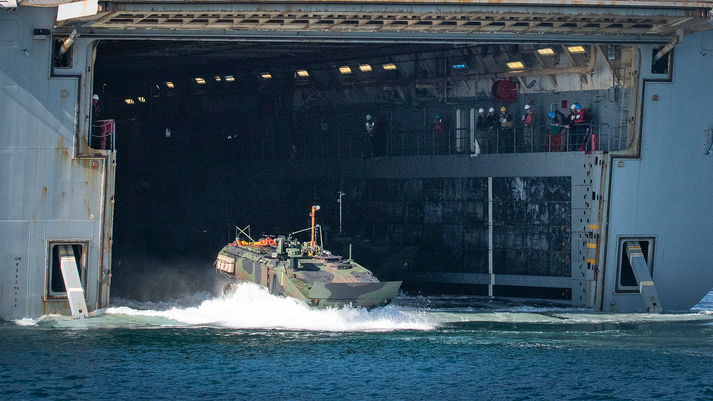BAE Systems Testing ACV for Marine Corps Recon Program

WASHINGTON – BAE Systems is offering the Marine Corps an alternative to its proposal to produce a new-start platform for the Advanced Reconnaissance Vehicle program by demonstrating a new version of its Amphibious Combat Vehicle, which is currently operational.
“We like to believe there is an advantage in a proven platform,” that has great land and water mobility and significant survivability, BAE representative Mark Brinkman said May 10. The advantages of adapting the ACV for the recon requirement include a single established parts supply line, a single school house for vehicle drivers and maintenance personnel, and an active production line, he said.
Brinkman discussed the BAE proposal next to a basic ACV that has been modified with an assortment of sensors and defensive systems required for the reconnaissance vehicle, on display at the Modern Day Marine exposition at the Walter E. Washington Convention Center.
The demonstration vehicle had optical and infrared sensors, a small tethered unmanned aerial vehicle, the ability to carry and command and control a larger class-two UAV, and counter-UAV systems. The modified ACV would support a vehicle commander, a driver and five sensor operators, each with a multi-function operating station, Brinkman said.
The Advanced Reconnaissance Vehicle program would replace the existing Light Armor Vehicle, which functions as a scout and troop support platform, but is nearing its end-of-service life. The Marine Corps has given contracts to General Dynamics Land Systems and Textron Systems to develop prototypes for the ARV. But BAE, on its own initiative, will test a modified ACV this summer, provide it for Marine testing and then submit a detailed proposal next year, Brinkman said.
A potential drawback for the BAE proposal is the Marines’ requirement for a vehicle weight limit of 37,000 pounds, set to allow four vehicles to be carried on an LCAC ship-to-shore connector. The BAE ACV weighs about 35 tons – 70,000 pounds.
Brinkman said the ACV’s weight is offset by its “ability to swim” from ship to shore, reducing the need for a connector, like the LCAC.
But that could minimize the standoff distance for the amphibious shipping as the ACV swims at about 7 knots, compared to the 30-knot water speed of the LCAC.